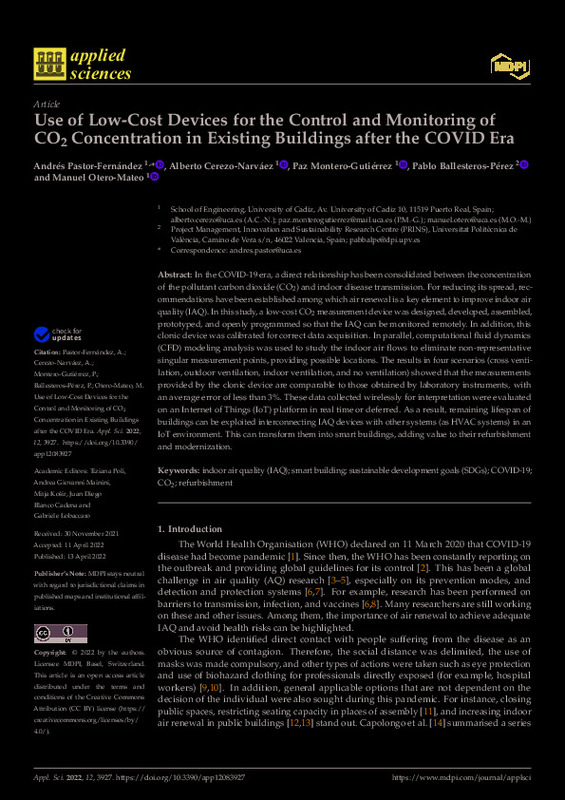JavaScript is disabled for your browser. Some features of this site may not work without it.
Buscar en RiuNet
Listar
Mi cuenta
Estadísticas
Ayuda RiuNet
Admin. UPV
Use of Low-Cost Devices for the Control and Monitoring of CO2 Concentration in Existing Buildings after the COVID Era
Mostrar el registro sencillo del ítem
Ficheros en el ítem
| dc.contributor.author | Pastor-Fernández, Andrés
|
es_ES |
| dc.contributor.author | Cerezo-Narváez, Alberto
|
es_ES |
| dc.contributor.author | Montero-Gutiérrez, Paz
|
es_ES |
| dc.contributor.author | Ballesteros-Pérez, Pablo
|
es_ES |
| dc.contributor.author | Otero-Mateo, Manuel
|
es_ES |
| dc.date.accessioned | 2022-11-23T19:01:20Z | |
| dc.date.available | 2022-11-23T19:01:20Z | |
| dc.date.issued | 2022-04 | es_ES |
| dc.identifier.uri | http://hdl.handle.net/10251/190115 | |
| dc.description.abstract | [EN] In the COVID-19 era, a direct relationship has been consolidated between the concentration of the pollutant carbon dioxide (CO2) and indoor disease transmission. For reducing its spread, recommendations have been established among which air renewal is a key element to improve indoor air quality (IAQ). In this study, a low-cost CO2 measurement device was designed, developed, assembled, prototyped, and openly programmed so that the IAQ can be monitored remotely. In addition, this clonic device was calibrated for correct data acquisition. In parallel, computational fluid dynamics (CFD) modeling analysis was used to study the indoor air flows to eliminate non-representative singular measurement points, providing possible locations. The results in four scenarios (cross ventilation, outdoor ventilation, indoor ventilation, and no ventilation) showed that the measurements provided by the clonic device are comparable to those obtained by laboratory instruments, with an average error of less than 3%. These data collected wirelessly for interpretation were evaluated on an Internet of Things (IoT) platform in real time or deferred. As a result, remaining lifespan of buildings can be exploited interconnecting IAQ devices with other systems (as HVAC systems) in an IoT environment. This can transform them into smart buildings, adding value to their refurbishment and modernization. | es_ES |
| dc.description.sponsorship | All authors acknowledge the help received by the research group TEP-955 from the PAIDI, the ERGOMET Project of the Program for the Promotion of Research Activity of the UCA, the Project "Design of a low-cost non-invasive ergonomic capture system for the analysis of musculoskeletal disorders" of the Program for the Promotion of Research and Transfer of the UCA and the National Plan Research Project PID2019-108669RB-100/AEI/10.13039/501100011033. | es_ES |
| dc.language | Inglés | es_ES |
| dc.publisher | MDPI AG | es_ES |
| dc.relation.ispartof | Applied Sciences | es_ES |
| dc.rights | Reconocimiento (by) | es_ES |
| dc.subject | Indoor air quality (IAQ) | es_ES |
| dc.subject | Smart building | es_ES |
| dc.subject | Sustainable Development Goals (SDG) | es_ES |
| dc.subject | COVID-19 | es_ES |
| dc.subject | CO2 | es_ES |
| dc.subject | Refurbishment | es_ES |
| dc.subject.classification | PROYECTOS DE INGENIERIA | es_ES |
| dc.title | Use of Low-Cost Devices for the Control and Monitoring of CO2 Concentration in Existing Buildings after the COVID Era | es_ES |
| dc.type | Artículo | es_ES |
| dc.identifier.doi | 10.3390/app12083927 | es_ES |
| dc.relation.projectID | info:eu-repo/grantAgreement/AEI/Plan Estatal de Investigación Científica y Técnica y de Innovación 2017-2020/PID2019-108669RB-I00/ES/DERECHO E INTELIGENCIA ARTIFICIAL: NUEVOS HORIZONTES JURIDICOS DE LA PERSONALIDAD Y LA RESPONSABILIDAD ROBOTICAS/ | es_ES |
| dc.relation.projectID | info:eu-repo/grantAgreement/Junta de Andalucía//TEP-955/ | es_ES |
| dc.rights.accessRights | Abierto | es_ES |
| dc.contributor.affiliation | Universitat Politècnica de València. Escuela Técnica Superior de Ingenieros Industriales - Escola Tècnica Superior d'Enginyers Industrials | es_ES |
| dc.description.bibliographicCitation | Pastor-Fernández, A.; Cerezo-Narváez, A.; Montero-Gutiérrez, P.; Ballesteros-Pérez, P.; Otero-Mateo, M. (2022). Use of Low-Cost Devices for the Control and Monitoring of CO2 Concentration in Existing Buildings after the COVID Era. Applied Sciences. 12(8):1-35. https://doi.org/10.3390/app12083927 | es_ES |
| dc.description.accrualMethod | S | es_ES |
| dc.relation.publisherversion | https://doi.org/10.3390/app12083927 | es_ES |
| dc.description.upvformatpinicio | 1 | es_ES |
| dc.description.upvformatpfin | 35 | es_ES |
| dc.type.version | info:eu-repo/semantics/publishedVersion | es_ES |
| dc.description.volume | 12 | es_ES |
| dc.description.issue | 8 | es_ES |
| dc.identifier.eissn | 2076-3417 | es_ES |
| dc.relation.pasarela | S\461072 | es_ES |
| dc.contributor.funder | Junta de Andalucía | es_ES |
| dc.contributor.funder | Agencia Estatal de Investigación | es_ES |
| dc.subject.ods | 03.- Garantizar una vida saludable y promover el bienestar para todos y todas en todas las edades | es_ES |
| dc.subject.ods | 09.- Desarrollar infraestructuras resilientes, promover la industrialización inclusiva y sostenible, y fomentar la innovación | es_ES |
| dc.subject.ods | 11.- Conseguir que las ciudades y los asentamientos humanos sean inclusivos, seguros, resilientes y sostenibles | es_ES |








